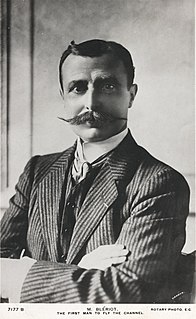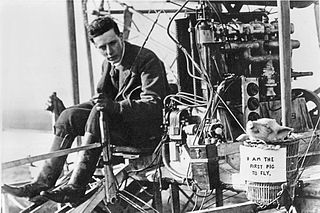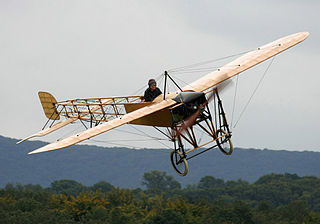| VII | |
|---|---|
 | |
| Antoinette VII example showing seating arrangement for two | |
| Role | Experimental aircraft |
| Manufacturer | Antoinette |
| Designer | Léon Levavasseur |
| First flight | 1909 |
The Antoinette VII was an early French aircraft, flown in 1909.
| VII | |
|---|---|
 | |
| Antoinette VII example showing seating arrangement for two | |
| Role | Experimental aircraft |
| Manufacturer | Antoinette |
| Designer | Léon Levavasseur |
| First flight | 1909 |
The Antoinette VII was an early French aircraft, flown in 1909.
The VII was a further development of the Antoinette IV, with increased engine power and using a wing warping system implemented by Levavasseur for the Antoinette V in place of the Antoinette IV's ailerons.
With this aircraft, Levavasseur hoped that Antoinette test pilot Hubert Latham would be able to make the crossing of the English Channel that he had previously attempted in the Antoinette IV and claim the Daily Mail prize then on offer. As it happened, the Antoinette VII's first flight took place on 25 July 1909, the same day that Louis Blériot succeeded in crossing the channel in his Blériot XI. Undaunted, Latham made the attempt anyway on 27 July. Unfortunately, the result was the same, with Latham making a forced landing this time within sight of the English coast only 1.6 km (0.99 mi) away. He and the aircraft were rescued by HMS Russell.


The following month, Latham flew the same aircraft at the Grande Semaine d'Aviation de la Champagne , winning the prize for altitude (155 m, 509 ft) and coming second in the contest for the fastest circuit, with a speed of 68.9 km/h, 42.8 mph [1]
General characteristics
Performance
Related lists List of aircraft (pre-1914)

Louis Charles Joseph Blériot was a French aviator, inventor, and engineer. He developed the first practical headlamp for cars and established a profitable business manufacturing them, using much of the money he made to finance his attempts to build a successful aircraft. Blériot was the first to use the combination of hand-operated joystick and foot-operated rudder control as used to the present day to operate the aircraft control surfaces. Blériot was also the first to make a working, powered, piloted monoplane. In 1909 he became world-famous for making the first airplane flight across the English Channel, winning the prize of £1,000 offered by the Daily Mail newspaper. He was the founder of Blériot Aéronautique, a successful aircraft manufacturing company.
This is a list of aviation-related events from 1910:

This is a list of aviation-related events from 1909:

Antoinette was a French manufacturer of light petrol engines. Antoinette also became a pioneer-era builder of aeroplanes before World War I, most notably the record-breaking monoplanes flown by Hubert Latham and René Labouchère. Based in Puteaux, the Antoinette concern was in operation between 1903 and 1912. The company operated a flying school at Chalons for which it built one of the earliest flight simulators.

The Blériot XI is a French aircraft of the pioneer era of aviation. The first example was used by Louis Blériot to make the first flight across the English Channel in a heavier-than-air aircraft, on 25 July 1909. This is one of the most famous accomplishments of the pioneer era of aviation, and not only won Blériot a lasting place in history but also assured the future of his aircraft manufacturing business. The event caused a major reappraisal of the importance of aviation; the English newspaper The Daily Express led its story of the flight with the headline "Britain is no longer an Island".

Blériot Aéronautique was a French aircraft manufacturer founded by Louis Blériot. It also made a few motorcycles between 1921 and 1922 and cyclecars during the 1920s.

The Antoinette IV was an early French monoplane.

The Antoinette V was an early French aircraft, first flown on 20 December 1908.
The Antoinette VI was an early French aircraft, flown in 1909. It was a development of the Antoinette IV, its major technological advance being that it was fitted with true ailerons, whereas the former aircraft had ailerons mounted as separate surfaces on the trailing edges of the wings. Nevertheless, Levavasseur was not satisfied with this innovation and later modified the aircraft to use a wing warping system similar to that fitted to the Antoinette V.

The Antoinette military monoplane, also known as the Antoinette Monobloc or the Antoinette-Latham was an early 3-seat monoplane built in France in 1911 by the Antoinette company in the hope of attracting orders from the French military. It featured a futuristic and aerodynamic design with innovative elements that were ahead of its time, including unbraced cantilever wings, an enclosed fuselage and wheel fairings, and an engine with steam cooling and direct fuel injection. However, due to an under-powered engine, it was barely able to fly and failed to attract orders.

The Blériot XII was an early French aeroplane built by Louis Blériot. It was first flown in May 1909 and was the first aircraft to be flown with two passengers on board, and was used by Blériot to gain second place in the 1909 Gordon Bennett Cup and to set a new world speed record.

The Farman III, also known as the Henry Farman 1909 biplane, was an early French aircraft designed and built by Henry Farman in 1909. Its design was widely imitated, so much so that aircraft of similar layout were generally referred to as being of the "Farman" type.

The Goupy No.2 was an experimental aircraft designed by Ambroise Goupy and Mario Calderara and built in France in 1909 at the Blériot factory at Buc. The Goupy No.2 is significant for two major and influential innovations in aircraft design: it was the first tractor configuration biplane to fly and the first biplane to feature staggered wings, built with a landing gear configuration nearly identical in appearance to the Blériot XI monoplane, flown earlier that year. While both these features would very soon become the norm in aircraft design, the No.2 was described in the aviation press at the time as having a "somewhat unusual design". The only features that would not be typical of aircraft in the years to come would be its biplane tail unit, and the whole-chord wingtip ailerons fitted to both upper and lower wings. The uncovered wood box-girder fuselage, typical of early aircraft, was later covered.

Arthur Charles Hubert Latham was a French aviation pioneer. He was the first person to attempt to cross the English Channel in an aeroplane. Due to engine failure during his first of two attempts to cross the Channel, he became the first person to land an aeroplane on a body of water.
The Blackburn Second Monoplane was strongly influenced by the French Antoinette and was much more successful than Robert Blackburn's first aircraft. The lone aircraft was built in Leeds, UK in 1910.

Léon Levavasseur was a French powerplant engineer, aircraft designer and inventor. His innovations included the V8 engine, direct fuel injection, and liquid engine cooling. Primarily associated with the Antoinette company, he continued to experiment with aircraft design after the company went bankrupt.

The Gastambide-Mengin monoplane was an early French experimental aircraft designed by Léon Levavasseur, and was the first aircraft built by the Antoinette company. The name came from Jules Gastambide, who financed the company, and Gabriel Mengin, the aircraft engineer.

The Grande Semaine d'Aviation de la Champagne was an 8-day aviation meeting held near Reims in France in 1909, so-named because it was sponsored by the major local champagne growers. It is celebrated as the first international public flying event, confirming the viability of heavier-than-air flight.

Tha Antoinette III was a pioneer aircraft developed in France during 1908.

The pioneer era of aviation was the period of aviation history between the first successful powered flight, generally accepted to have been made by the Wright Brothers on 17 December 1903, and the outbreak of the First World War in August 1914.
| Wikimedia Commons has media related to Antoinette VII . |